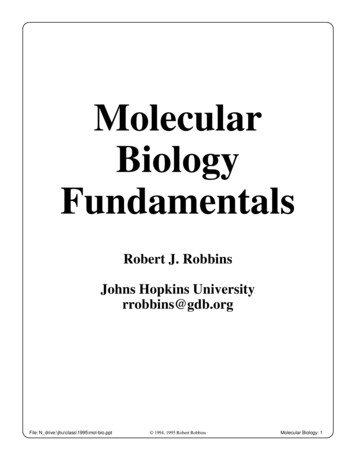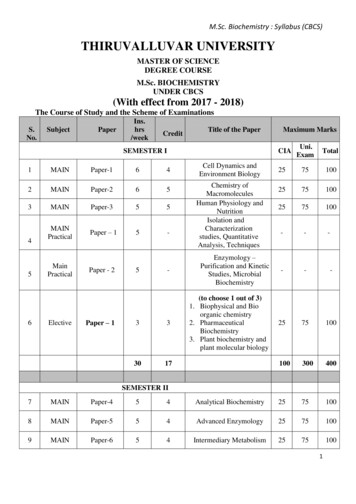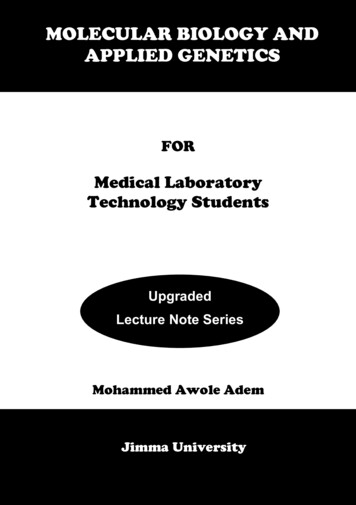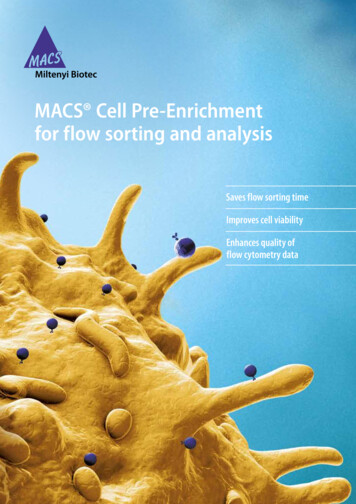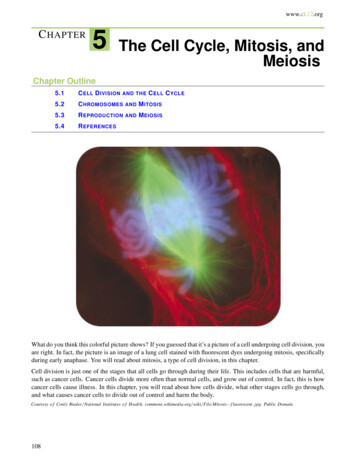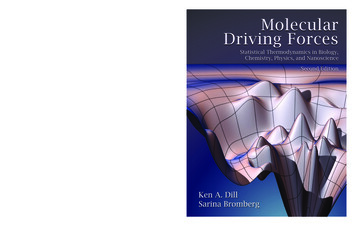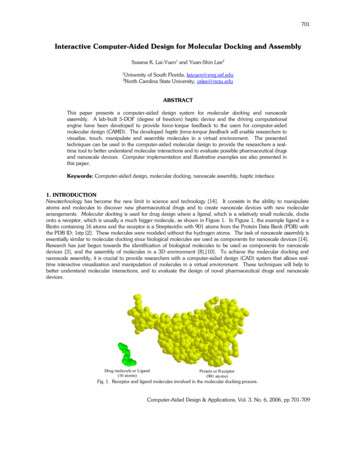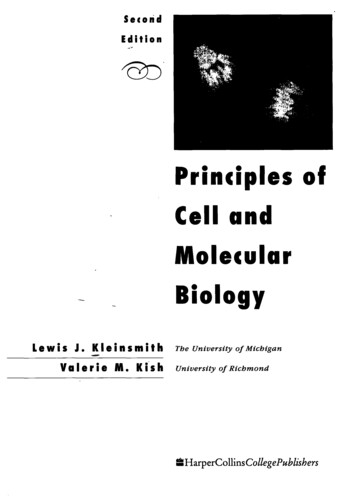
Transcription
Principles ofCell a n dMolecularBiologyLewis J* KleinsmithValerie M. KishThe University of MichiganUniversity of Richmondim HarperCollinsCollegePublishers
Detailed Contents viiPrefacePart 1Background Concepts 1ChapterChapterChapterChapterPart 2xxv1234Prologue: Cells and Their Molecules3Energy and Enzymes 32The Flow of Genetic Information 60Experimental Approaches for StudyingCells 113Cell Organization153Chapter 5 Membranes and Membrane Transport155Chapter 6 The Cell Surface and CellularCommunication194Chapter 7 Cytoplasmic Membranes and IntracellularTraffic255Chapter 8 Mitochondria and the Capturing of EnergyDerived from Food309Chapter 9 Chloroplasts and the Capturing of EnergyDerived from Sunlight 354Chapter 10 The Nucleus and Transcription of GeneticInformation400Chapter 11 The Ribosome and Translation of GeneticInformation469Chapter 12 Cell Cycles and Cell Division 517Chapter 13 The Cytoskeleton and Cell Motility 562Chapter 14 Evolution of Cells and Genetics of CellOrganelles 631v
Part 3Formation of Specialized Cells 671Chapter 15 Gametes, Fertilization, and EarlyDevelopment673Chapter 16 Lymphocytes and the Immune Response714Chapter 17 Neurons and Synaptic Signaling 747Chapter 18 Cancer Cells and Growth Control 777Glossary" CreditsG-lC-lIndex 1-1
DetailedContentsPrefacexxvPart 1Background Concepts1Chapter 1Prologue: Cells and Their Molecules 3An Overview of Cell Organization 4The Discovery of Cells Led to the Formulation of theCell Theory 4Cells Perform Four Basic Functions 5Membranes and Walls Create Barriers andCompartments 5The Nucleus and Ribosomes Function in the Rowof Genetic Information 8Mitochondria and Chloroplasts Play Key Roles inMetabolism 9Cytoskeletal Filaments Function in Cell Motility9Prokaryotic and Eukaryotic Cells Differ in TheirStructural Complexity 9Cells Are Limited as to How Small or Large TheyCan Be 10Molecular Composition of Cells 10Water Is the Most Abundant Substance in Cells 11Water Acts as Both Chemical Reactant and Solvent13Most Biological Molecules Are Constructed fromSugars, Fatty Acids, Nucleotides, and AminoAcids 14Sugars Are the Building Blocks of Polysaccharides14Fatty Acids Are Employed in the Construction ofMany Types of Lipids 15Nucleotides Are the Building Blocks of NucleicAcids 19 VII
VIIIDetailed ContentsAmino Adds Are the Building Blocks of Proteins19Each Protein Has a Unique Amino Acid SequenceKnown as Its Primary Structure 21The Secondary Structure of Protein MoleculesInvolves a Helices and fi Sheets 21Tertiary Structure Creates Globular Proteins ThatAre Folded into Domains 24Quaternary Structure Creates Proteins That Consistof Multiple Subunits 26Proper Conformation Is Essential for ProteinFunction 26What Are Viruses? 27Viruses Are Infectious Agents That Are SmallerThan Cells 28Viruses Consist ofDNA or RNA Surrounded by aProtein Coat 28Viruses Reproduce inside Living Cells 29Viruses May Have Evolved from Ancient Cells 30Summary of Principal PointsSuggested Readings3031Chapter 2Energy and Enzymes32Energy Flow in Living Cells 33The First Law of Thermodynamics States ThatEnergy Can Be neither Created nor Destroyed33The Second Law of Thermodynamics States Thatthe Entropy of the Universe Is Always Increasing34Changes in Free Energy Determine the Direction inWhich Reactions Proceed 34AG ' Determines the Direction in Which ReactionsProceed under Standard Conditions 35AG' Determines the Direction in Which ChemicalReactions Actually Proceed inside CeUs 36Enzymes and Catalysis 36Enzymes Function as Biological Catalysts 3 7Enzymes Are Almost Always Proteins 37Enzymes Are More Efficient, Specific, andControllable Than Other Catalysts 38Mechanism of Enzyme Action 39Catalysts Speed Up Reactions by Lowering theActivation Energy (AG*) 39Enzymes Lower Activation Energy by Reducing theEnergy and/or Entropy Changes Associated withthe Transition State 40An Enzyme-Substrate Complex Is Formed DuringEnzymatic Catalysis 40Enzyme Specificity Is Explained by the Shape of theActive Site 41The Catalytic Efficiency of the Active Site Is Basedon a Combination of Factors 42Enzyme Kinetics and Regulation 43Vmax and Km Provide Information about anEnzyme's Catalytic Efficiency and SubstrateAffinity 43Values for Vmax and Km Can Be Determined Usingthe Michaelis-Menten Equation 44Enzyme Activity Is Influenced by pH andTemperature 46Enzymes May Require Coenzymes, ProstheticGroups, and Metal Ions for Optimal Activity 46Enzyme Inhibitors Can Act Irreversibly orReversibly 47Allosteric Regulation Involves Reversible Changesin Protein Conformation Induced by AllostericActivators and Inhibitors 51Allosteric Enzymes Exhibit CooperativeInteractions between Subunits 52Enzyme Activity Can Be Regulated by CovalentModifications of Protein Structure 53Enzyme Activity Can Be Regulated by theAssociation and Dissociation of Subunits 55Coupled Reactions and the Role of ATP 55ATP Plays a Central Role in Transferring FreeEnergy 55The Nucleotides GTP, UTP, and CTP Are AlsoInvolved in Transferring Free Energy 56Coenzymes Such as NAD* and FAD Play a CentralRole in Coupled Oxidation-Reduction Reactions57Summary of Principal Points 58Suggested Readings59Chapter 3The Flow of Genetic Information60Identifying DNA as the Genetic Material 61The Scientist Who Discovered DNA Concluded ThatIt Could Not Be Involved in the Transmission ofHereditary Information 62The Idea That DNA Stores Genetic Information WasWidely Held by the Late Nineteenth Century62The Idea That DNA Stores Genetic Information WasRejected Shortly after It Was First Proposed 62Genetic Transformation Studies Revived the IdeaThat DNA Stores Hereditary Information 63The Idea That DNA Encodes Genetic InformationWas Experimentally Verified by the Early 1950s64DNA Structure and Replication 65DNA Is a Double Helix 65DNA Is Replicated by a SemiconservativeMechanism Based on Complementary BasePairing 67DNA Is Replicated by DNA Polymerase 69
Detailed ContentsDNA Polymerases Catalyze DNA Synthesis in the5' — 3' Direction 71DNA Synthesis Is Initiated Using ShortUNA Primers72Unwinding a DNA Double Helix RequiresHelicases, Single-Stranded DNA Binding Proteins,and Topoisomerases 73The Process of DNA Replication Is Complicated byChromosome Structure 74Retroviruses Employ Reverse Transcriptase toSynthesize DNA 74DNA Transcription and Translation 75Experiments on Neurospora Led to the OneGene-One Enzyme Theory 75The Base Sequence of a Gene Usually Codes for theSequence of Amino Acids in a Polypeptide Chain76Messenger RNA Carries Information from DNA toNewly Forming Polypeptide Chains 78The Base Sequence of Messenger RNA Is Copiedfrom DNA by the Enzyme RNA Polymerase81Messenger RNA Becomes Associated withRibosomes 81The Base Sequence of Messenger RNA Determinesthe Amino Acid Sequence of a Polypeptide Chain82Genetic Information Encoded in DNA Is Expressedby a Two-Stage Process Involving Transcriptionand Translation 83RNA Splicing Often Accompanies the Production ofEukaryotic Messenger RNAs 84The Genetic Code Is a Triplet Code 84The Coding Dictionary Was Established UsingSynthetic RNA Polymers and RNA Triplets85Of the 64 Possible Codons in Messenger RNA, 61Code for Amino Acids 85The Genetic Code Contains Special Stop and StartSignals 87The Genetic Code Is Nearly Universal 88Transfer RNAs Bring Amino Acids to the RibosomeDuring Protein Synthesis 88Each Transfer RNA Binds to a Specific Amino Acidand to Messenger RNA 89Transfer RNAs Contain Anticodons That RecognizeCodons in Messenger RNA 89DNA Mutation, Repair, and Rearrangement 90Spontaneous Mutations Limit the Fidelity of DNAReplication 90Mutations Are Also Caused by EnvironmentalChemicals and Radiation 92Mutations Are Stabilized by Subsequent Rounds ofDNA Replication 93ixExcision Repair Corrects Mutations That InvolveAbnormal Bases 93Mismatch Repair Corrects Mutations That InvolveNoncomplementary Base Pairs 94Transposable Elements Promote theRearrangement of DNA Base Sequences 95Recombinant DNA and Gene Cloning 96Nucleic Acid Hybridization Techniques Are Used toDetermine Whether Two Nucleic Acids ContainSimilar Base Sequences 96Southern and Northern Blotting AllowHybridization to Be Carried Out with NucleicAcids Separated by Electrophoresis 97In Situ and Colony Hybridization Allow NucleicAcids to Be Identified in Cells 98The Discovery of Restriction Endonucleases Pavedthe Way for Recombinant DNA Technology98Gene Cloning Techniques Permit Individual DNASequences to Be Produced in Large Quantities99Rapid Procedures Exist for Determining the BaseSequence of DNA Molecules 104DNA Molecules of Defined Sequence Can BeSynthesized by Chemical Procedures 105The Polymerase Chain Reaction Allows IndividualGene Sequences to Be Produced in LargeQuantities without Cloning 105Practical Applications of DNA Technology 106Genetic Engineering Has Facilitated the Productionof Useful Proteins 106Genetic Engineering of Plants Is Helping toIncrease Crop Yields 107DNA Fingerprinting Is a New Way of IdentifyingIndividuals for Legal Purposes 107Recombinant DNA Technology Is Being Used in theDiagnosis and Treatment of Genetic Diseases108Summary of Principal PointsSuggested Readings 111111Chapter 4Experimental Approaches for Studying Cells 113Growing Cells in the Laboratory 114Animal, Plant, and Bacterial Cells Can Be Grownin the Laboratory 114Primary Cell Cultures and Transformed Cell LinesDiffer in Their Properties 116Hybrid Cells Can Be Created by the Technique ofCell Fusion 117Viewing Cells with a Microscope 117The Light Microscope Can Visualize Objects asSmall as 200 Nanometers in Diameter 118Specialized Kinds of Light Microscopy Permit theVisualization of Living Cells 119
XDetailed ContentsThe Electron Microscope Can Visualize Objects asSmall as 0.2 Nanometers in Diameter 122The Transmission Electron Microscope Forms anImage from Electrons That Pass through theSpecimen 122Specimens Are Usually Sectioned and Stained Priorto Examination with the Transmission ElectronMicroscope 122Freeze-Fracturing and Freeze-Etching Are UsefulTechniques for Examining the InteriorOrganization of Cell Membranes 124The Scanning Electron Microscope Reveals theSurface Architecture of Cells and Organelles125Scanning Probe Microscopes Reveal the SurfaceFeatures of Individual Molecules 127Using Microscopy to Localize Molecules inside Cells128Staining Reactions Can Localize Specific Kinds ofMolecules within Cells 128Antibodies Are Powerful Tools for LocalizingProteins and Other Antigens inside Cells 130Cytochemical Procedures Can Localize the Activityof Specific Enzymes within a CeU 131Microscopic Autoradiography Is Employed to LocateRadioactive Molecules within a Cell 132Centrifugation and Subcellular Fractionation 133Differences in Size and Density Are the MainFactors That Govern the Behavior of ParticlesDuring Centrifugation 133Velocity Centrifugation Separates Organelles andMolecules Based Mainly on Differences in Size135 —Isodensity Centrifugation Separates Organellesand Molecules Based on Differences in Density135Isolating Organelles Requires That Cells First BeBroken Open in an Appropriate Medium 137Homogenates Are Separated by DifferentialCentrifugation into Nuclear, Mitochondrial,Microsomal, and Cytosol Fractions 138Techniques for Studying Macromolecules 139Spectrophotometry Can Be Used to Detect Proteinsand Nucleic Acids 140Radioactive Isotopes Are a Sensitive Way ofDetecting Tiny Amounts of Material 141Antibodies Are Sensitive Tools for Detecting SpecificProteins 142The Monoclonal Antibody Technique GeneratesLarge Quantities of Identical Antibody Molecules142Dialysis and Precipitation Are Used to SeparateLarge Molecules from Small Molecules 143Electrophoresis Separates Macromolecules Based onDifferences in Size and Electric Charge 144Chromatography Separates Molecules Based onDifferences in Their Affinities for Two Phases146X-Ray Diffraction Reveals the Three-DimensionalStructures of Macromolecules 149Summary of Principal Points 150Suggested Readings151Part 2Cell Organization153Chapter 5Membranes and Membrane Transport 155Models of Membrane Architecture 156Cellular Membranes Contain a Lipid Bilayer156The Davson-Danielli Model Was the First DetailedRepresentation of Membrane Organization157Membranes Exhibit a Trilaminar Appearance inElectron Micrographs 157The Davson-Danielli Model Failed to Explain ManyAspects of Membrane Behavior 158The Fluid Mosaic Model Is a More AccurateRepresentation of Membrane Architecture160Membrane Lipids l6lPhospholipids, Glycolipids, and Steroids Are thePredominant Membrane Lipids 161Membrane Lipids Spontaneously Form BilayersBecause They Are Amphipathic 161The Lipid Bilayer Is Fluid 162Membrane Fluidity Can Be Altered by Changes inLipid Composition 165Lipids Are Arranged Asymmetrically across theBilayer 165Membrane Proteins 167Radioactive Labeling Procedures Permit theOrientation of Membrane Proteins to Be Studied167Membranes Contain Integral, Peripheral, andLipid-Anchored Proteins 168Some Membrane Proteins Are Free to Move withinthe Lipid Bilayer 169The Mobility of Membrane Proteins Is Variable170Membrane Proteins Are Oriented Asymmetrically—The Red Cell Membrane as a Model 171Membrane Proteins Can Consist of Different Kindsof Subunits 174Transport Across Cellular Membranes 175Diffusion Is the Net Movement of a SubstanceDown Its Concentration Gradient 175
Detailed ContentsOsmosis Is Caused by the Diffusion of WaterMolecules through a Semipermeable Membrane176Simple Diffusion of Solute Molecules Is Influencedby Their Lipid Solubility, Size and ElectricCharge 177Membrane Transport Proteins Have Evolved to Aidthe Transport Process 178Membrane Transport Proteins Are Identified byAffinity Labeling and Membrane ReconstitutionTechniques 180How to Determine the Energy Requirements for theTransport of Uncharged Molecules 180How to Determine the Energy Requirements for IonTransport 181Facilitated Diffusion Is the Assisted Movement of aSubstance Down Its Electrochemical Gradient182The Glucose Transporter Mediates the FacilitatedDiffusion of Glucose 183Band 3 Protein Is an Anion Exchanger ThatMediates the Facilitated Diffusion ofBicarbonate and Chloride Ions 184Ion Channels Mediate the Facilitated Diffusion ofSmall Ions 184Active Transport Involves Membrane Carriers ThatMove Substances against an ElectrochemicalGradient 186ATP Can Provide Energy for Active Transport—The Na -K Pump as a Model 186Phosphoenolpyruvate Can Provide Energy forActive Transport—The PhosphotransferaseSystem as a Model 188Light Can Provide Energy for Active Transport—Bacteriorhodopsin as a Model —189Electron Transfer Reactions Can Provide Energy forActive Transport 190Ion Gradients Can Provide Energy for ActiveTransport—Na -Linked Transport of Sugars andAmino Acids as a Model 190Proton Gradients Can Provide Energy for ActiveTransport—H*-Linked Transport of Lactose as aModel 191Membranes Also Move Materials by theBudding and Fusion of Membrane Vesicles192Summary of Principal Points 192Suggested Readings192Chapter 6The Cell Surface and Cellular Communication 194The Membrane Potential 195The Donnan Equilibrium and Nernst EquationDescribe How the Passive Distribution of IonsInfluences the Membrane Potential 196xiActive Transport Influences the MembranePotential 197The Goldman Equation Takes into Account theContributions of Multiple Ions to the MembranePotential 198Changes in Membrane Potential Act as a SignalingDevice in Nerve and Muscle Cells 198The Action Potential Is Produced by Changes inMembrane Permeability to Na and K 199Voltage-Gated Ion Channels Control the MovementofNa and K* During an Action Potential201Inhibitors of Ion Transport Can Block the Na* andK* Channels 202The Permeability of Voltage-Gated Ion Channels IsControlled by Sequential ConformationalChanges 202An Overview of Signaling Molecules and TheirReceptors 202Hormones Are Transported by the CirculatorySystem to Target Cells Located throughout theBody 203Neurotransmitters Are Released into Synapses byNerve Cells 205Local Mediators Act on Neighboring Cells 205Hormones, Neurotransmitters, and Local MediatorsTransmit Signals by Binding to Receptors 205Receptors Are Identified by Testing Their Ability toBind to Radioactive Signaling Molecules 206Most Receptors for External Signaling MoleculesAre Located in the Plasma Membrane 208Ion Channel Receptors 208The Nicotinic Acetylcholine Receptor Has BeenIsolated and Purified 208The Nicotinic Acetylcholine Receptor Acts as aNeurotransmitter-Gated Ion Channel 210Receptors Linked To G Proteins 211Cyclic AMP Functions as a Second Messenger 211G Proteins Transmit Signals between PlasmaMembrane Receptors and Adenylyl Cyclase 212Some G Proteins Inhibit Rather than StimulateAdenylyl Cyclase 213G Proteins Are Disrupted by Bacterial Toxins ThatCause Cholera and Whooping Cough 214Cyclic AMP Activates Protein Kinase A 214Different Proteins Are Phosphorylated in DifferingTarget Cells by Protein Kinase A 216Advantages of the Cyclic AMP System IncludeAmplification and Flexibility 217G Proteins Can Alter the Permeability of IonChannels 218G Proteins Are Involved in the PhosphoinositideSignaling Pathway 218Inositol Trisphosphate (IP3) Is a Second MessengerThat Mobilizes Calcium Ions 219
XIIDetailed ContentsDiacylglycerol (DAG) Is a Second Messenger ThatActivates Protein Kinase C 221Catalytic Receptors 221Many Growth Factors Interact with Receptors ThatFunction as Protein-Tyrosine Kinases 221Receptors Exhibiting Guanylyl Cyclase ActivityProduce the Second Messenger Cyclic GMP 222Receptors Are Grouped into Superfamilies 222Signaling Responses Are Terminated by Reducingthe Concentration of Signaling Molecules orActive Receptors 223The Extracellular Matrix 224The Ground Substance of the Extracellular MatrixIs Formed by Glycosaminoglycans andProteoglycans 224Collagen Is Primarily Responsible for the Strengthof the Extracellular Matrix 226Collagen Is Produced from a Precursor MoleculeCalled Procollagen 228Elastin Imparts Elasticity and Flexibility to theExtracellular Matrix 229Fibronectin Binds Cells to the Matrix and GuidesCellular Migration 230Laminin Binds Cells to the Basal Lamina 231Integrin Receptors Bind to Fibronectin, Laminin,and Other Matrix Constituents 231The Glycocalyx Is a Carbohydrate-Rich ZoneLocated at the Periphery of Many Animal Cells232Cell-Cell Recognition and Adhesion 233N-CAMs and Cadherins Are Plasma MembraneGlycoproteins That Mediate Cell-Cell Adhesion233Carbohydrate Groups ParticipateJn Cell-CellRecognition and Adhesion 234Cell Junctions 236Tight Junctions Create a Permeability Barrieracross a Layer of Cells 236Plaque-Bearing Junctions Stabilize Cells againstMechanical Stress 238Gap Junctions Permit Small Molecules to Movefrom One Cell to Another 240The Plant Cell Surface 243Plant Cell Walls Provide a Supporting Frameworkfor Intact Plants 243The Plant Cell Wall Is Constructed from Cellulose,Hemicellulose, Pectin, Lignin, and Glycoproteins243The Plant Cell Wall Is Synthesized in SeveralDiscrete Stages 245Plasmodesmata Permit Direct Cell-CellCommunication through the Plant Cell Wall246Chemical and Electrical Signaling Occur in Plantsas Well as Animals 247The Bacterial Cell Surface 248Gram-Positive Bacteria Have a Thick Cell WallMade ofMurein and Teichoic Acids 248Gram-Negative Bacteria Have a Thin Murein Wallplus an Outer Membrane 250Synthesis of the Bacterial Cell Wall Is Blocked byPenicillin 251The Periplasmic Space Is a Unique Compartmentoutside the Plasma Membrane of Gram-NegativeBacteria 251Capsules Are Often Produced by Gram-Positive andGram-Negative Bacteria 251Summary of Principal PointsSuggested Readings252253Chapter 7Cytoplasmic Membranes and Intracellular Traffic225The Endoplasmic Reticulum 256The Endoplasmic Reticulum Consists of TwoComponents: The Smooth ER and the Rough ER257The Smooth ER Is Involved in Releasing FreeGlucose from Glycogen 259The Smooth ER Is Involved in SynthesizingTriacylglycerols and Steroids 260The Smooth ER Synthesizes the PhospholipidsNeeded for Cellular Membranes 260The Smooth ER Oxidizes Foreign Substances UsingCytochrome P-450 261The Rough ER Is Involved in Protein Targeting 263Signal Sequences Target Proteins to theEndoplasmic Reticulum 264Proteins Synthesized on Membrane-BoundRibosomes Pass through Protein-TranslocatingChannels in the ER Membrane 265Integral Membrane Proteins Contain Stop-TransferSequences as Well as Signal Sequences 268Insertion or Translocation into the ER Can AlsoOccur after a Protein Has Been Synthesized268Newly Made Proteins Are Modified in the ER byN-Linked Glycosylation, Hydroxylation, andLinkage to Membrane-Bound Glycolipid 269Newly Formed Proteins Acquire Their ProperConformation in the ER 270The Golgi Complex 272The Golgi Complex Consists of a Stack of FlattenedMembrane Cisternae and Associated Vesicles272Proteins Synthesized in the Rough ER Are Routedthrough the Golgi Complex 274Vesicles Transport Materials between theEndoplasmic Reticulum and the Golgi Complex277
Detailed ContentsProteins Are Glycosylated as They Pass through theGolgi Complex 279The Golgi Complex Is Also Involved in SynthesizingPolysaccharides 279Proteins Are Sorted by the Golgi Complex UsingChemical Signals and Bulk Flow 281The Golgi Complex Produces Various Kinds ofIntracellular Granules 281Cell Secretion 283Secretion Can Be Either Constitutive or Regulated283Vesicles Destined for the Constitutive andRegulated Secretory Pathways Can BeDistinguished from One Another 283Cleavage of Precursor Proteins Often Occurs inImmature Secretory Vesicles 284Materials Are Expelled from Cells by Exocytosis284Membrane Components Are Recycled from thePlasma Membrane Back to the Golgi Complex285Bacterial Cells Secrete Materials Directly throughthe Plasma Membrane 286Lysosomes and Endocytosis 286Acid Phosphatase Is Localized within a MembraneEnclosed Organelle 286Acid Phosphatase and Other Acid Hydrolases ArePackaged Together in Lysosomes 287Plant Spherosomes Are Specialized LysosomesExhibiting a High Lipid Content 289Lysosomes Are Formed by a Pathway That UsesMannose 6-Phosphate as a Targeting Signal290Some Proteins Are Targeted to the Lysosome by aMannose 6-Phosphate Independent Pathway291Lysosomes Are Involved in Macroautophagy,Microautophagy, Autolysis, and ExtracellularDigestion 292During Phagocytosis, Plasma Membrane VesiclesContaining Particulate Matter Are Brought intothe Cell and Fuse with Lysosomes 293During Pinocytosis, Plasma Membrane VesiclesContaining Fluid Are Brought into the Cell andFuse with Lysosomes 294Receptor-Mediated Endocytosis Brings SpecificMacromolecules into the Cell 295Receptor-Mediated Endocytosis Is Utilized forSeveral Purposes, Including Nutrient Deliveryand Signal Transduction 297Lysosomal Storage Diseases Are Caused by GeneticDefects in Lysosomal Enzymes 298Membrane Biogenesis 300How Are Phospholipids Inserted into CellularMembranes? 302XIIIHow Are Integral and Peripheral MembraneProteins Incorporated into Cellular Membranes?303How Are Lipid-Anchored Proteins Incorporated intoCellular Membranes? 304Summary of Principal PointsSuggested Readings305307Chapter 8Mitochondria and the Capturing of Energy Derivedfrom Food 309Anaerobic Pathways For Capturing Energy 310Energy is Released by Oxidation Reaction 310Coenzymes and ATP Play Central Roles inTransferring Energy from One Reaction toAnother 311Glucose Plays a Central Role as a Source of BothEnergy and Chemical Building Blocks 311Glycolysis Is the First Stage in Extracting Energyfrom Glucose 311Fermentation Replenishes NAD While ReducingPyruvate to Lactate or Ethanol 313The Two ATP Molecules Produced During theFermentation of Glucose Represent a RelativelySmaU Energy Yield 313Anatomy of the Mitochondrion 315Mitochondria Were First Discovered andFunctionally Described Using Microscopy andSubcellular Fractionation 315Mitochondria Have Outer and Inner MembranesThat Define Two Separate Compartments316Mitochondria Can Form Large InterconnectedNetworks 316Mitochondrial Membranes and Compartments CanBe Separated from Each Other for BiochemicalStudy 319The Outer Mitochondrial Membrane Is Permeableto Small Molecules 320The Mitochondrial Matrix Is the Site Where theKrebs Cycle Occurs 322The Inner Mitochondrial Membrane Is theMain Site of Mitochondrial ATP Formation 323How Mitochondria Capture Energy 324Pyruvate and Fatty Acids Are Oxidized to AcetylCoA in the Mitochondrial Matrix 324The Oxidation of Acetyl CoA in the Krebs CycleGenerates a Small Amount of ATP plus NADHand FADH2 326NADH and FADH2 Are Oxidized Back to NAD andFAD by the Respiratory Chain 326The Respiratory Chain Is Comprised of FourDifferent Classes of Molecules 327
xivDetailed ContentsRedox Potentials Indicate the Energetically MostFavorable Route for Electrons Passing throughthe Respiratory Chain 328Difference Spectra Reveal the Sequence of theRespiratory Chain within Intact Mitochondria330The Respiratory Chain Is Organized into FourMultiprotein Complexes 331The Respiratory Chain Contains Three CouplingSites for Oxidative Phosphorylation 332The F'i-Fo Complex Is the Site of ATP SynthesisDuring Oxidative Phosphorylation 333An Electrochemical Proton Gradient across theInner Mitochondrial Membrane Drives ATPFormation 335A Maximum of 38 Molecules of ATP Are Producedper Molecule of Glucose Oxidized 340Molecules Involved in Mitochondrial MetabolismAre Actively Transported across the InnerMitochondrial Membrane 342Allosteric Regulation Plays an Important Role inControlling Glucose Oxidation 343Respiratory Control Regulates the Flow of Electronsthrough the Respiratory Chain 344The Light and Dark Reactions of PhotosynthesisAre Linked by NADPH and ATP 357Anatomy of the Chloroplast 358Early Light Microscopic Studies Identified theChloroplast as the Site of Photosynthesis 358Chloroplasts Contain Membranes That DefineThree Separate Compartments 358The Main Components of the Chloroplast Can BeIsolated for Biochemical Study 362Chloroplasts Are Enclosed by a RelativelyPermeable Outer Membrane and anImpermeable Inner Membrane 362The Chloroplast Stroma Is the Site ofC02 Fixation364Thylakoid Membranes Contain Unusual Lipids andNumerous Proteins Involved in the LightReactions 365Chapter 9Chloroplasts and the Capturing of Energy Derivedfrom Sunlight 354The Light Reactions of Photosynthesis 366Chlorophyll Is the Principal Light-AbsorbingPigment in Thylakoid Membranes 366Carotenoids and Other Accessory Pigments FunnelLight Energy to Chlorophyll 367Photosystems Are Formed from a Mixture ofChlorophylls, Carotenoids, and Proteins 368The Photosynthetic Electron Transfer Chain IsAnalogous to the Mitochondrial RespiratoryChain 370Two Photosystems Are Involved in thePhotosynthetic Electron Transfer Chain ofChloroplasts 371The Photosynthetic Electron Transfer Chain IsOrganized into Several Protein Complexes ThatTransfer Electrons from Water to NADP* 371ATP Is Synthesized by Both Noncyclic and CyclicPhotophosphorylation 374The Photosynthetic Electron Transfer ChainContains Two Coupling Sites forPhotophosphorylation 375Membrane Reconstitution Studies Have RevealedThat the CFj-CFo Complex Is an ATP Synthase377An Electrochemical Proton Gradient across theThylakoid Membrane Drives ATP Formation377Photosystems I and II Are Spatially Separated inStacked and Unstacked Thylakoids 383LHCIIActs as a Regulator ofPhotosystem Activity385Early Studies of Photosynthesis 355The Basic Equation of Photosynthesis Was Derivedfrom the Independent Observations of SeveralScientists 355Chloroplasts Carry Out Photosynthesis in TwoStages Called the Light and Dark Reactions 356The COrFixing Dark Reactions 385Experiments Using Radioactive CO2 First Revealedthe Role Played by the Calvin Cycle in CO2Fixation 386Glyceraldehyde 3-Phosphate Is the PrincipalProduct of CO2 Fixation by the Calvin Cycle 388How Bacteria Capture Energy 344The Respiratory Chain and OxidativePhosphorylation Occur in the Plasma Membraneof Bacterial Cells 344An Electrochemical Proton Gradient across theBacterial Plasma Membrane Drives OxidativePhosphorylation 346Peroxisomes and Related Organelles 347Peroxisomes Were Discovered by IsodensityCentrifugation 347Peroxisomes Contain Enzymes Involved in theProduction and Breakdown of HydrogenPeroxide 348Peroxisomes Perform Several Metabolic Functions349Glyoxysomes Are Used by Plants to SynthesizeCarbohydrates from Lipids 350Glycosom.es Are Used by Trypanosomes to Speed UpGlycolysis 351Summary of Principal Points 352Suggested Readings 352
Detailed ContentsThe Calvin Cycle Requires 18 Molecules of ATP and12 Molecules ofNADPH when Converting CO2 toGlucose 388Combining the Light Reactions with the CalvinCycle Generates the Overall Equation ofPhotosynthesis 389Molecules Involved in Chloroplast Metabolism AreSelectively Transported across the InnerChloroplast Membrane 389Light Regulates the Activity of Rubisco and OtherCalvin Cycle Enzymes 390Photorespiration and C4 Plants 391Photorespiration Occurs When O2 Substitutes forCO2 in the Reaction Catalyzed by Rubisco 391C4 Plants Minimize Photorespiration by Using aSpecial Pathway for Concentrating CO2 392CAM Plants Produce Malate at Night and Use It toProvide CO2 to the Calvin Cycle During the Day394Photosynthesis in Prokaryotes 396The Light Reactions in Purple and Green BacteriaUtilize Only One Photosystem 396Photosynthetic Bacteria Can Make NADPH UsingElectron Donors Other Than Water 398Halobacterium Captures Solar Energy withoutFixing CO2 or Other Electron Acceptors 398Summary of Principal Points 398Suggested Readings399Chapter 10The Nucleus and Transcription of GeneticInformation 400The Nucleus and Nucleoid 402The Nucleus ofEukaryotic CeUs Is Bounded by aDouble-Membrane Envelope 402The Nuclear Envelope Is Supported by the NuclearLamina and Contains Numerous Nuclear PoreComplexes 403Nuclear Pore Complexes Are Channels throughWhich Molecules Enter and Exit the Nucleus 404The Nucleoplasm Is the Soluble Portion of theNucleus 407The Nucleolus Contains Granules and FibrilsInvolved in Ribosome Formation 407The Nuclear Matrix Provides a SupportingFramework for the Nucleus 408
Principles of Cell and Molecular Biology Lewis J* Kleinsmith The University of Michigan . Chapter 18 Cancer Cells and Growth Control 777 Glossary G-l " Credits C-l Index 1-1 . Detailed Contents . Changes i
